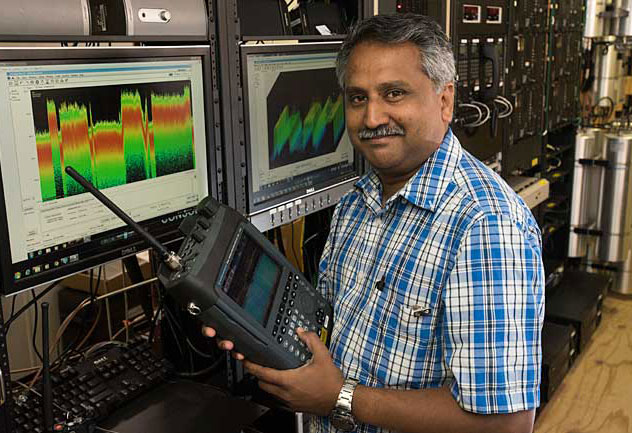Facilities and Infrastructure
Spectrum Management Capabilities
The Instrumentation Department’s Spectrum and Radio Communications Group oversees Brookhaven’s licensed use of the federal radio-frequency (RF) spectrum to support critical missions in national security, science, and operations. The group also manages land-mobile radio (LMR) systems to provide wireless communication for life and property protection and accelerator science, and performs electromagnetic interference (EMI) and electromagnetic compatibility (EMC) testing of electronic components.
Our Capabilities
- Assignment of RF frequencies—for example, for radar operations, accelerator science, and national security programs such as the Radiological Assistance Program—based on engineering analysis and multiagency coordination to ensure the interference-free, efficient use of the RF spectrum
- Evaluation of technical and regulatory compliance of RF devices under consideration for procurement and operation
- Operation and management of LMR critical infrastructure systems for accelerator science and police, fire, emergency management, and other responders to facilitate critical communications for life and property protection missions
- Operation and management of very-high-frequency (VHF) paging systems for scientific experiments conducted in environments where commercial pagers and cell phones would not function due to the presence of heavy shielding, structures below ground level (e.g., tunnels), and high levels of background noise—for example, at Brookhaven’s Relativistic Heavy Ion Collider, National Synchrotron Light Source II, and Collider-Accelerator Department
- Measurement of EMI and EMC in electronic components with state-of-the-art RF equipment and RF-shielded enclosures for mitigating external RF noise, with comb generators to assess shielding effectiveness
- Evaluation of small-scale electronic systems for EMI and EMC compliance
- Application of technical expertise to other laboratory systems using RF equipment, such as the site fire alarm system and outdoor warning system
- Triangulation of intentional and unintentional RF-radiating sources of interference with state-of-the art automated digital direction-finding equipment mounted in a mobile platform for agile response
- Deployment of a mobile platform for interoperable communications response
- Measurement of ultra-low-noise, ultra-wideband signals with 9 kHz to 40 GHz and 512 MHz real-time spectrum analyzers
- Prediction of coverage for conventional RF systems and mesh networks with RF propagation analysis software
- Assessment of antenna performance with analyzers capable of measuring the distance to a fault along a transmission line
- Detection of extremely low-powered RF signals
- Characterization of passive and active systems via spectrum analyzers, vector network analyzers, and tracking generators
- Identification and characterization of in-building RF signals in the 9 kHz to 8 GHz spectrum through handheld spectrum analyzers and receivers
Case Studies
Range Extension
We deployed LMR infrastructure to extend the range of communication among security personnel at several high-profile events, including the 2013 Super Bowl, 2015 papal visits to Philadelphia and New York City, and 2016 Democratic National Convention.
Identifying RF Quiet Zones
Radio astronomy requires the identification of dead zones in the RF spectrum where radio telescopes can operate without RF pollution. We performed studies to identify such quiet zones for the Baryon Mapping Experiment (BMX) radio telescope. Under construction by Brookhaven’s Physics Department and Instrumentation Department, the BMX telescope will probe of the structure and dynamics of our galaxy.





